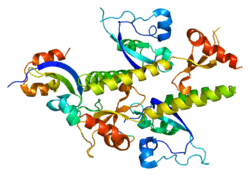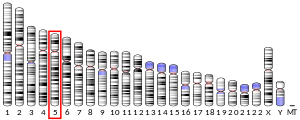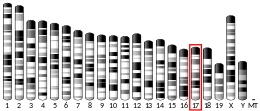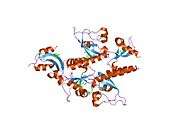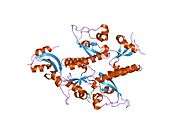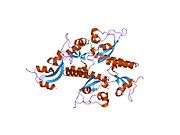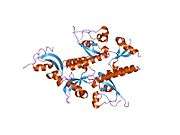CHD1
Chromodomain-helicase-DNA-binding protein 1 is an enzyme that in humans is encoded by the CHD1 gene.[5][6][7]
The CHD family of proteins is characterized by the presence of chromo (chromatin organization modifier) domains and SNF2-related helicase/ATPase domains. CHD genes alter gene expression possibly by modification of chromatin structure thus altering access of the transcriptional apparatus to its chromosomal DNA template.[7]
Interactions
CHD1 has been shown to interact with Nuclear receptor co-repressor 1.[8]
gollark: Ethics < randomly generating actions.
gollark: I don't agree with it unless the actual people in question are going around, well, killing people/being at war/etc.
gollark: There are of course still ethical issues even if you don't like the users on them much.
gollark: Also, *are* there weird niche left-wing social media sites to hack?
gollark: * at
References
- GRCh38: Ensembl release 89: ENSG00000153922 - Ensembl, May 2017
- GRCm38: Ensembl release 89: ENSMUSG00000023852 - Ensembl, May 2017
- "Human PubMed Reference:". National Center for Biotechnology Information, U.S. National Library of Medicine.
- "Mouse PubMed Reference:". National Center for Biotechnology Information, U.S. National Library of Medicine.
- Delmas V, Stokes DG, Perry RP (March 1993). "A mammalian DNA-binding protein that contains a chromodomain and an SNF2/SWI2-like helicase domain". Proceedings of the National Academy of Sciences of the United States of America. 90 (6): 2414–8. Bibcode:1993PNAS...90.2414D. doi:10.1073/pnas.90.6.2414. PMC 46097. PMID 8460153.
- Woodage T, Basrai MA, Baxevanis AD, Hieter P, Collins FS (October 1997). "Characterization of the CHD family of proteins". Proceedings of the National Academy of Sciences of the United States of America. 94 (21): 11472–7. Bibcode:1997PNAS...9411472W. doi:10.1073/pnas.94.21.11472. PMC 23509. PMID 9326634.
- "Entrez Gene: CHD1 chromodomain helicase DNA binding protein 1".
- Tai HH, Geisterfer M, Bell JC, Moniwa M, Davie JR, Boucher L, McBurney MW (August 2003). "CHD1 associates with NCoR and histone deacetylase as well as with RNA splicing proteins". Biochemical and Biophysical Research Communications. 308 (1): 170–6. doi:10.1016/S0006-291X(03)01354-8. PMID 12890497.
External links
- Human CHD1 genome location and CHD1 gene details page in the UCSC Genome Browser.
Further reading
- Stokes DG, Perry RP (May 1995). "DNA-binding and chromatin localization properties of CHD1". Molecular and Cellular Biology. 15 (5): 2745–53. doi:10.1128/mcb.15.5.2745. PMC 230505. PMID 7739555.
- Bonaldo MF, Lennon G, Soares MB (September 1996). "Normalization and subtraction: two approaches to facilitate gene discovery". Genome Research. 6 (9): 791–806. doi:10.1101/gr.6.9.791. PMID 8889548.
- Kelley DE, Stokes DG, Perry RP (April 1999). "CHD1 interacts with SSRP1 and depends on both its chromodomain and its ATPase/helicase-like domain for proper association with chromatin". Chromosoma. 108 (1): 10–25. doi:10.1007/s004120050347. PMID 10199952.
- Salomon AR, Ficarro SB, Brill LM, Brinker A, Phung QT, Ericson C, et al. (January 2003). "Profiling of tyrosine phosphorylation pathways in human cells using mass spectrometry". Proceedings of the National Academy of Sciences of the United States of America. 100 (2): 443–8. Bibcode:2003PNAS..100..443S. doi:10.1073/pnas.2436191100. PMC 141014. PMID 12522270.
- Tai HH, Geisterfer M, Bell JC, Moniwa M, Davie JR, Boucher L, McBurney MW (August 2003). "CHD1 associates with NCoR and histone deacetylase as well as with RNA splicing proteins". Biochemical and Biophysical Research Communications. 308 (1): 170–6. doi:10.1016/S0006-291X(03)01354-8. PMID 12890497.
- Brandenberger R, Wei H, Zhang S, Lei S, Murage J, Fisk GJ, et al. (June 2004). "Transcriptome characterization elucidates signaling networks that control human ES cell growth and differentiation". Nature Biotechnology. 22 (6): 707–16. doi:10.1038/nbt971. PMID 15146197.
- Sims RJ, Chen CF, Santos-Rosa H, Kouzarides T, Patel SS, Reinberg D (December 2005). "Human but not yeast CHD1 binds directly and selectively to histone H3 methylated at lysine 4 via its tandem chromodomains". The Journal of Biological Chemistry. 280 (51): 41789–92. doi:10.1074/jbc.C500395200. PMC 1421377. PMID 16263726.
- Flanagan JF, Mi LZ, Chruszcz M, Cymborowski M, Clines KL, Kim Y, et al. (December 2005). "Double chromodomains cooperate to recognize the methylated histone H3 tail". Nature. 438 (7071): 1181–5. Bibcode:2005Natur.438.1181F. doi:10.1038/nature04290. PMID 16372014.
- Olsen JV, Blagoev B, Gnad F, Macek B, Kumar C, Mortensen P, Mann M (November 2006). "Global, in vivo, and site-specific phosphorylation dynamics in signaling networks". Cell. 127 (3): 635–48. doi:10.1016/j.cell.2006.09.026. PMID 17081983.
- Okuda M, Horikoshi M, Nishimura Y (January 2007). "Structural polymorphism of chromodomains in Chd1". Journal of Molecular Biology. 365 (4): 1047–62. doi:10.1016/j.jmb.2006.10.039. PMID 17098252.
- Ewing RM, Chu P, Elisma F, Li H, Taylor P, Climie S, et al. (2007). "Large-scale mapping of human protein-protein interactions by mass spectrometry". Molecular Systems Biology. 3 (1): 89. doi:10.1038/msb4100134. PMC 1847948. PMID 17353931.
This article is issued from Wikipedia. The text is licensed under Creative Commons - Attribution - Sharealike. Additional terms may apply for the media files.
